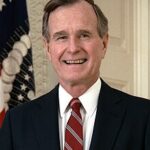Bush’s Strategic Diplomatic Approach
President George H.W. Bush faced unprecedented challenges as the Cold War entered its final phase. The Berlin Wall fell in November 1989, marking a pivotal moment in global history. Bush resisted calls for triumphant celebrations or provocative actions. His measured response demonstrated remarkable diplomatic wisdom during this critical period.
The Decision for Restraint
Bush chose strategic patience over public grandstanding when managing Soviet collapse. He avoided inflammatory rhetoric that could have destabilized the transition process 📊. The president prioritized long-term stability over short-term political gains. His administration worked quietly with Soviet leader Mikhail Gorbachev to ensure smooth transitions. This approach prevented potential conflicts during Germany’s reunification process.
Implementing Peaceful Transition
The administration focused on concrete diplomatic initiatives rather than symbolic gestures ⚠️. Bush supported economic aid programs for former Soviet states. He established personal relationships with emerging democratic leaders across Eastern Europe. The president carefully balanced NATO expansion concerns with Russian security interests 🌍. This balanced approach laid groundwork for post-Cold War international cooperation.
Impact:
Immediate Global Consequences
The peaceful end to the Cold War prevented potential military conflicts during the Soviet collapse 🔥. Germany reunified without triggering regional instability or refugee crises. Former Warsaw Pact nations transitioned to democracy through negotiations rather than violence. Nuclear tensions decreased dramatically as both superpowers reduced their arsenals. Eastern European countries gained independence through diplomatic processes rather than armed struggles.
Long-term International Effects
Bush’s approach established foundations for modern U.S.-Russia relations despite later tensions 🌍. NATO expansion proceeded gradually without immediate confrontation with Moscow. The European Union expanded eastward, integrating former communist states peacefully. International institutions adapted to include new democratic nations from Eastern Europe. Global military spending decreased as the arms race ended without catastrophic conflict.
Economic and Social Transformation
Market economies replaced communist systems across Eastern Europe with minimal violence 📉. International trade expanded as former Soviet bloc countries joined global markets. Democratic institutions developed organically rather than through forced regime change. The peaceful transition saved billions in potential military costs and reconstruction expenses 💰. Millions of people gained freedom and economic opportunities without enduring prolonged warfare or instability.
